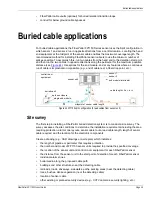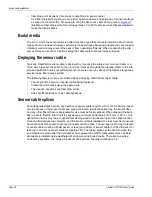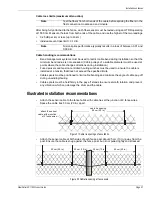
Buried cable applications
Page 44
FiberPatrol FP1150 Product Guide
Cable installation for tunneling detection
To detect tunneling activity, the sensor cable should be buried at least 2 m (6.5 ft.) below ground.
The deeper burial depth is necessary to prevent nuisance alarms caused by vibrations generated
by above ground activity. A burial depth of 2 m can detect tunneling activity up to 20 m below the
sensor cable. If it is expected that the tunnel will be deeper than 20 m, the sensor cable’s burial
depth should also be deeper.
Alarm communication
Due to the distributed nature of the control equipment in most long range buried sensor
applications, the alarm communication and reporting is usually performed at a central facility. The
FiberPatrol IDS software includes an alarm display and control application for local alarm
annunciation. For remote alarm reporting, FiberPatrol’s alarm communications are managed by
the Network Manager Service (NM). It is also possible to use the available dark fibers in the sensor
cable for alarm communication applications.
Equipment requirements
The total length of the fiber sensors (S1 and S2) in the fiber optic sensor cable (sensor cable and
lead cable) determines the model and number of processors for the FiberPatrol system. There are
specific FiberPatrol sensor units available for cable lengths up to 5 km (FP115005) and up to
40 km (FP115040) (up to 50 km for TPI).
Other required equipment includes:
•
two single end modules (depending on configuration)
•
1RU rack-mount fiber connection module (for head end fiber splices)
•
outdoor splice enclosure (1 required for each outdoor cable splice, or termination)
•
splice consumables kit (1 per 24 cable splices)
•
FiberPatrol cable vault for each outdoor splice location
•
Security Management System equipment and software
Dark fibers
Depending on the specific cable used for the installation there can be up to 22 dark fibers available
for other applications (e.g., communications, CCTV). When planning a FiberPatrol sensor system,
some consideration should be given to the available dark fibers and their potential uses. All dark
fibers that will be used for other applications must be fusion spliced along with the sensor fibers.






























